The fabric of Chinese culture
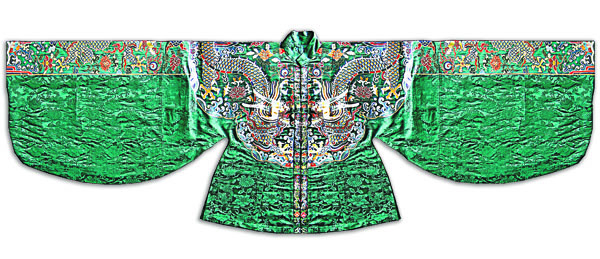
The Nanjing Yunjin Research Institute adopts yunjin technique in replicating cultural relics, including a garment that belonged to an empress from the Ming Dynasty (1368-1644). [Photo provided to China Daily]
Silk has always been interwoven with the nation's history, and the textiles that employ the fine material remain sought after the world over — arguably, none more so than hangluo gauze, Xu Haoyu reports.
Editor's note: There are 43 items inscribed on UNESCO's Intangible Cultural Heritage lists that not only bear witness to the past glories of Chinese civilization, but also continue to shine today. China Daily looks at the protection and inheritance of some of these cultural legacies. In this installment, we admire a much-coveted textile that threaded its way to every corner of the globe.
"The sun, the sun, like a golden shuttle; the moon, the moon, like a silver shuttle. They are handed to you and also to me, to see who weaves the most beautiful life," goes a popular song from the last century named The Golden and Silver Shuttles.
It was common back then, but relatively rarely seen now, to use the loom shuttle to metaphorically describe the passage of time; and through numerous small workshops and skillful hands, the resources bestowed by nature were transformed into useful and exquisite items for daily life.
The production of silk involves the cultivation of mulberry trees and the breeding and care of silkworms, which produce cocoons from which silk filaments are unwound. It is one of the things that, even today, remains firmly archaic — continuing to exist in a time when patience was not a scarce resource.
People have been weaving silk, which is known as si in Chinese, into fabric for more than 5,000 years.
Once upon a time, when spring transitioned into summer, the Grand Canal, a vast waterway system connecting Beijing and Hangzhou in today's Zhejiang province, presented a bustling scene. Countless boats traversed the waterway, transporting exquisite fabrics. This precious cargo would take two months to reach the capital city, where they would be transformed into cool and lightweight robes, and worn as the favored attire of officials and nobility.
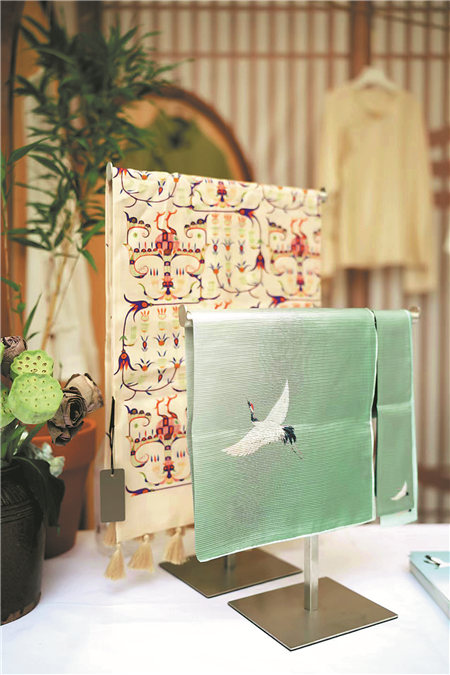
Scarves made of hangluo gauze, a type of silk fabric produced in Hangzhou, Zhejiang province. [Photo provided to China Daily]
Silk has also played a significant role in Chinese interactions with the rest of the world. The Silk Road, a network of trade routes connecting the East with the West, was established during the Han Dynasty (206 BC-AD 220) and facilitated the exchange of goods, ideas, and cultural practices. Chinese silk was one of the main goods traded, traveling as far as Rome and becoming a symbol of wealth and status in many cultures along the route.
"Silk has a particularly profound historical background and cultural accumulation, and is an important symbol of Chinese civilization. It has been an important carrier of Chinese culture since ancient times, and remains so today," says Wang Hairong, director of the China Silk Dijin Limited Company, a subsidiary corporation of the China Silk Corporation.
"Silk combines the beauty of art and technology," she says.
The sericulture and silk craftsmanship of China was listed in the Intangible Cultural Heritage of Humanity by UNESCO in 2009.
In the 5,000-year-old silk culture of China, fabrics such as ling, luo, chou, and duan represent the evolving techniques of textile production throughout different periods. Originating from silkworms and refined through looms, the varying weaving methods ultimately result in differences in shape and tactility.
The luo weaving technique stands out, particularly for the demanding level of craftsmanship.
Characterized by its openwork patterns, luo fabrics offer enhanced breathability. The technique originated sometime during the Spring and Autumn (770-476 BC) or Warring States (475-221 BC) periods, and gained popularity during the Song Dynasty (960-1279), mostly due to the attire required for official rituals and the impressive plain-woven silk textiles produced in Hangzhou, which are called hangluo.
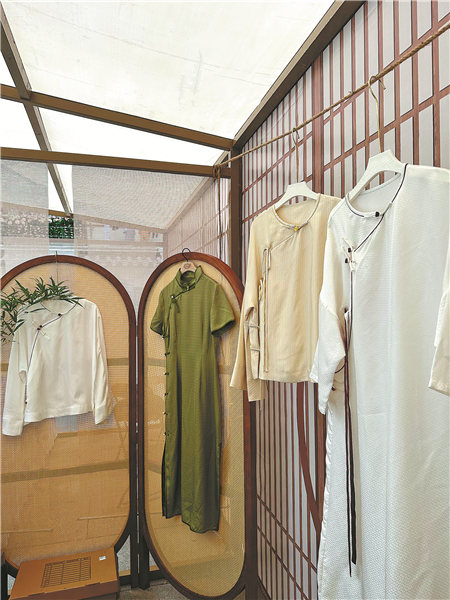
Clothes made of hangluo gauze, a type of silk fabric produced in Hangzhou, Zhejiang province. [Photo provided to China Daily]
Threads of the past
The value of hangluo is derived from two main aspects. First, its exceptional raw materials. The climate in the region is mild, making it an ideal place for mulberry cultivation. Second, the technique is incredibly refined.
Mulberry silk nourished by the soil and water of the Qiantang area has to go through a series of steps — including soaking, reeling, warping, threading the heddles and reeds, waxing, and shaking the warp — before it can be woven on the machine. The rough fabric then undergoes a fine-tuning process and dyeing to become the exquisite hangluo gauze.
During the golden era of the hangluo-making industry, there were at least thousands of households involved in the entire production chain, running related businesses from sericulture to dyeing workshops, especially around the Genshanmen area in Hangzhou.
As time passed, the loom used to produce hangluo underwent several transformations, yet the production process still requires a large amount of meticulous hand craftsmanship.
In an era of mechanical production, inheriting a traditional craft is not easy, says Zhang Chunqing, 44, head of the Hangluo Conservation Organization.
Before weaving hangluo on the loom, there is almost a monthlong process of organizing the warp and weft threads.
"Similar to the practices of the Song Dynasty, we soak the silk in clear water and add a secret ancestral formula. It takes 25 to 28 days for the silk to be ready, and only then can we weave the fabric, resulting in a lightweight, cool, and comfortable gauze," explains Zhang.
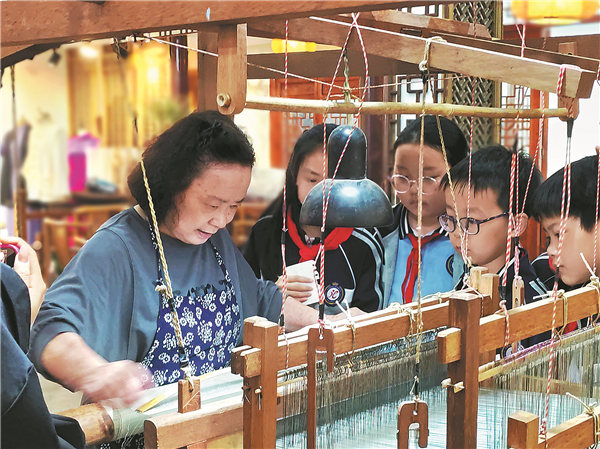
Hong Guizhen, an inheritor of hangluo craftsmanship, shows students the weaving technique. [Photo provided to China Daily]
Craftsmen must often immerse their hands in water, even in the cold winter, resulting in chapped and cracked skin on their hands. Most people cannot endure such discomfort, and many potential silk makers quit.
Due to the complexity of the process, the weaving technique of hangluo was almost lost. Yet, inheritors like Zhang and his parents-in-law, Shao Guanxing and Hong Guizhen, are striving to keep the craft alive.
In the 1980s, Shao and his wife, Hong, the fourth-generation representative inheritors of hangluo craftsmanship, managed to restore and improve the manual loom technique through persistent practice.
Originally, it took a skilled craftsman eight hours to hand-weave approximately 80 centimeters to 1 meter of gauze. After the family's improvement, around 8 meters can be woven in the same amount of time.
Shao, who was born in 1954 into a family of craftsmen in Hangzhou, grew up in a weaving workshop. Since his grandfather learned the weaving technique at the end of the Qing Dynasty (1644-1911), the family has been practicing the craft for over 150 years.
The technique is considered "a means of subsistence, which cannot be stolen, cannot be burned, and will always keep us from starvation", Shao says.
His early memories were filled with scenes of nearly every household in the Genshanmen area producing hangluo. His father would pull a cart filled with the fabric to the nearby canal dock to sell it. With the money he'd receive, he would buy some oil, salt, rice, meat, and other groceries.
Shao loved following his father to sell hangluo, which allowed him to visit the city center and witness the bustling silk trade at the canal dock. His father would usually buy him a few candies, which were incredibly precious in an era of material scarcity.
This childhood memory, filled with warmth related to hangluo, encouraged him to collect and preserve the remaining eight traditional wooden looms from that time. In 1984, he expanded his family's small workshop into the Fuxing Silk Factory.
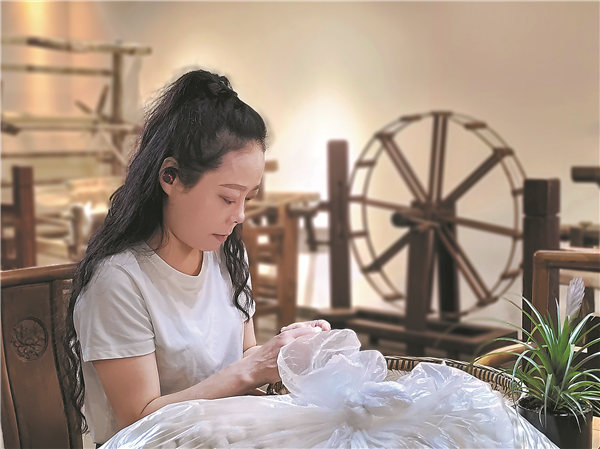
Shao Guofei, daughter of Hong Guizhen, carries on her family's traditional craft of hangluo weaving. [Photo provided to China Daily]
Shuttling to the future
Zhang, originally from Beijing, used to study finance as his major and had never come into contact with hangluo before moving to Hangzhou.
The first time he stepped into Shao's weaving factory, he found it quite hard to adapt to its harsh realities. The factory environment, due to the demands of hangluo weaving, was dark, damp, and had a particular smell.
He found it hard to believe that such a delicate and ethereal fabric was produced in such an environment.
Later, when he heard Shao mentioning that running a hangluo business wasn't profitable and sometimes even ran at a loss, he suggested halting its production and switching to other more economically viable silk trades.
At that time, Shao didn't comment on Zhang's suggestion but proposed that he make him a set of hangluo clothes, which completely blew Zhang's mind.
"The outfit was light and extremely breathable. I couldn't help but marvel at the existence of such an extraordinary fabric," Zhang recalls.
He never mentioned closing down the factory again. Instead, he followed Shao to the factory every day, humbly learning the various production processes of the gauze.
Over the past few years, Zhang has been dedicated to the protection and inheritance of hangluo weaving technique.
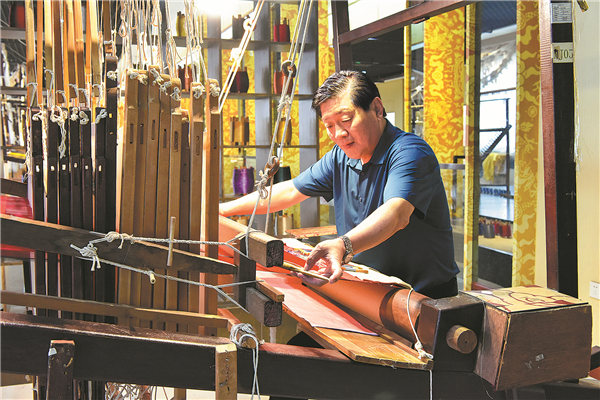
Zhou Shuangxi, a national-level inheritor of yunjin craftsmanship. [Photo provided to China Daily]
"We have built a special loom that enables hangluo to be introduced into schools. Children can get hands-on experience with weaving. This approach significantly strengthens their understanding of the technique in a more intuitive way."
Continuous innovation, including enriching the colors of the fabric, has been effective in helping to evolve hangluo in recent times.
Zhang says: "Switching from the original monochrome to a variety of color styles, hangluo has broadened its appeal. Recently, we have also been trying new things in terms of improvements to the technique. We hope to adapt to the different functional requirements for modern clothing, such as sun protection and wrinkle resistance, by changing the structure of the fibers."
What's more, in order to change the impression that hangluo is a luxury beyond the reach for many, Zhang plans to introduce it into ordinary households through brand building, communication and product development.
"We will cooperate with companies from different fields and use modern media communication methods to enable everyone to see the charm of hangluo," Zhang says.
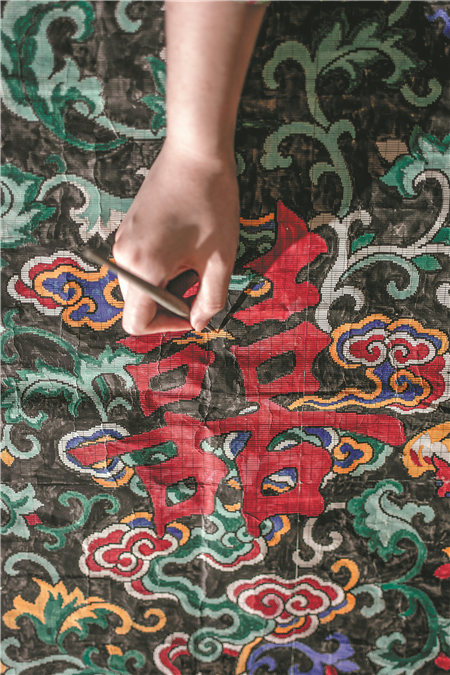
Before weaving, artisans transcribe and amplify the patterns to be woven onto a piece of grid paper. [Photo provided to China Daily]
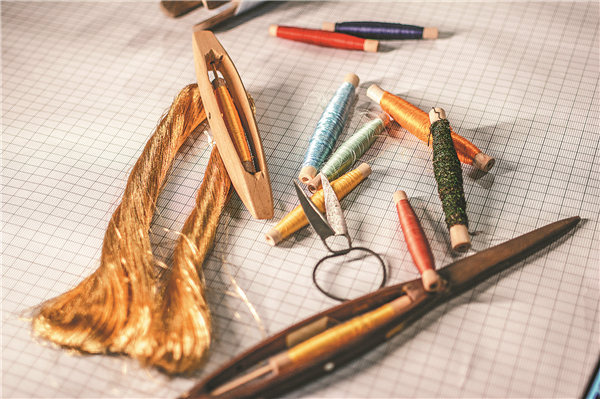
The production of yunjin uses refined raw material including silk and gold foiled threads. [Photo provided to China Daily]
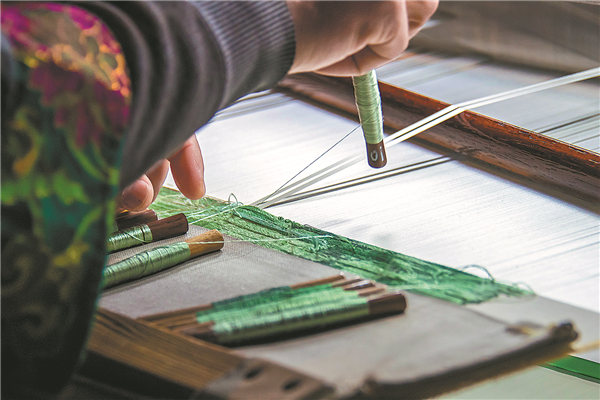
During production, weavers pass a shuttle over and under the alternating warps. [Photo provided to China Daily]
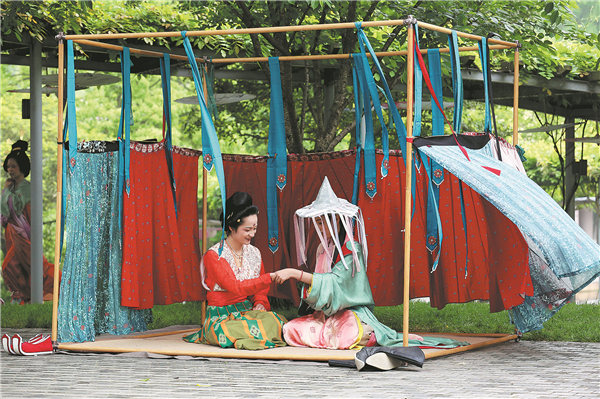
The China National Silk Museum in Hangzhou, Zhejiang province, hosts a costume festival in April. [Photo provided to China Daily]
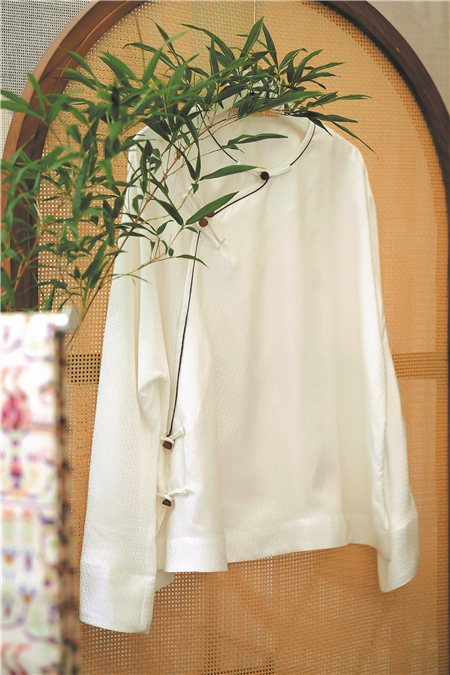
Clothes made of hangluo gauze, one of the most sought-after silk fabrics in the country. [Photo provided to China Daily]
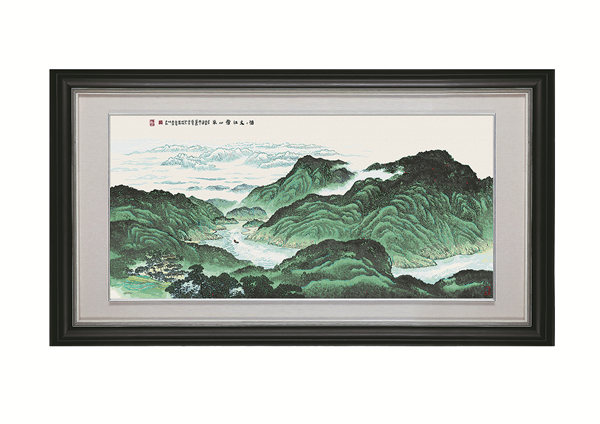
Replica of a traditional landscape painting using yunjin technique. [Photo provided to China Daily]
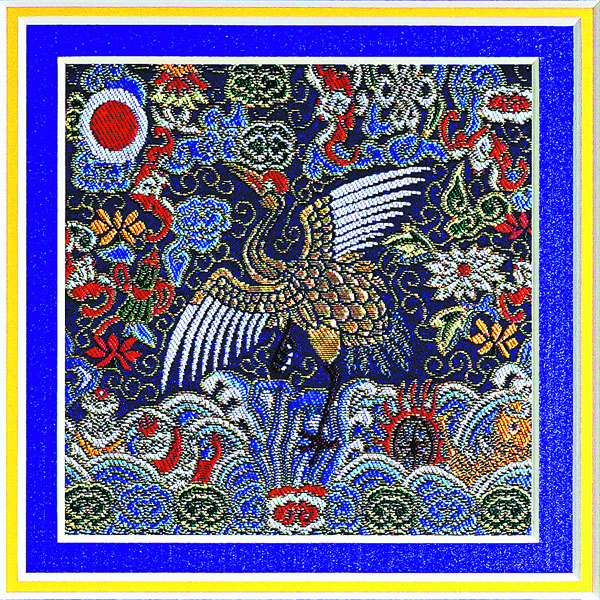
The Nanjing Yunjin Research Institute develops a series of merchandise such as framed yunjin fabric pieces. [Photo provided to China Daily]
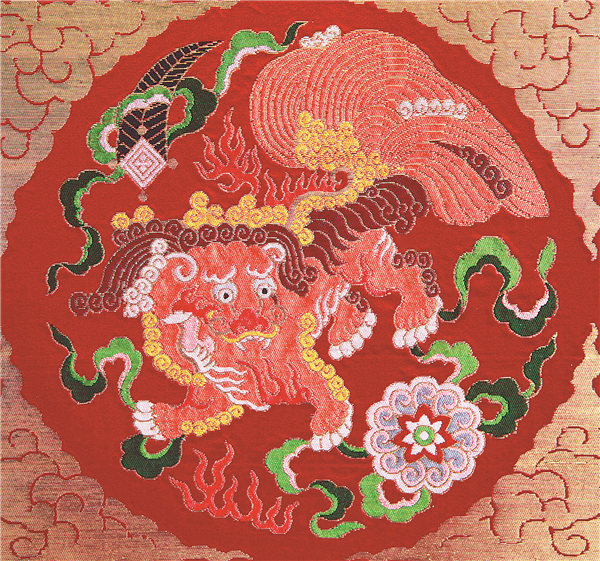
A brocade piece featuring auspicious patterns shown at the Nanjing Yunjin Museum. [Photo by Jian Hua/For China Daily]
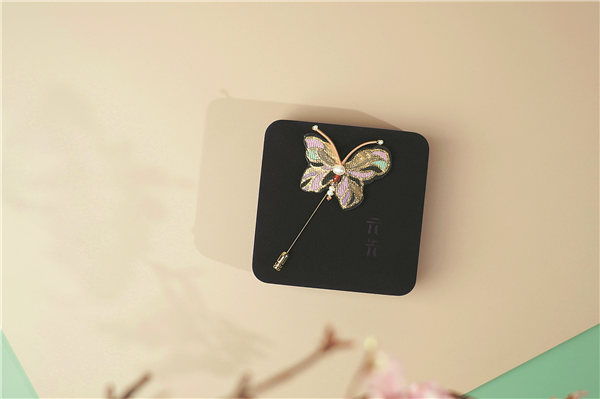
The butterfly brooch is one of the most popular merchandise at the Nanjing Yunjin Museum. [Photo provided to China Daily]
Related articles
-
 Bringing heritage to life in the modern era
Bringing heritage to life in the modern eraMore
-
 Traditional Chinese elements shine at fiber event
Traditional Chinese elements shine at fiber eventMore
-
 The importance of tea historically and today
The importance of tea historically and todayMore
-
 Chinese netizens explore ChatGPT
Chinese netizens explore ChatGPTMore
-
 How a folk art preserves history and culture
How a folk art preserves history and cultureMore
-
 Christopher Nolan: 'Oppenheimer' still relevant to world today
Christopher Nolan: 'Oppenheimer' still relevant to world todayMore
